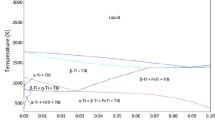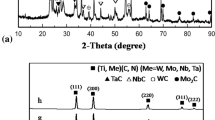The ternary boride based cermets Mo2FeB2 were fabricated successfully with Mo, FeB, Fe, Cr and Ni mixed-powders by mechanical ball milling and reaction boronizing sintering. The results indicate that, there is no alloying reaction between powders during milling; at milling times from 4 to 24 h, the morphology of mixed-powder becomes finer and the distribution becomes more and more uniform; however, as milling time exceeds 24 h, the morphology and distribution have no obvious change. The bulk Mo2FeB2 can be fabricated with sintering temperature increasing from 1437 K to 1517 K. The relative density, the hardness and bending strength increase with the temperature increasing from 1437 to 1477 K; however, the relative density has no obvious change and the hardness, bending strength decrease with the temperature exceeding 1477 K. The result also indicates that, when the sintering time increases from 25 to 50 min, the relative density, the hardness and bending strength of sample increase; however, the relative density has no obvious change and the hardness, bending strength decrease with the time exceeding 50 min.













Similar content being viewed by others
References
K. I. Takagi, “High tough boride base cermets produced by reaction sintering,” Mater. Chem. Phys., 67, 214–219 (2001).
K. Takagi, Y. Yamasaki, and M. Komai, “High-strength boride base hard materials,” J. Solid State Chem., 133, No. 1, 243–248 (1997)
K. Nishiyama, M. Keino, Y. Furuyama, et al., “Internal friction of boride cermets at elevated temperatures,” J. Alloys Compd., 355, No. 1–2, 97–102 (2003).
H. Yu, W. Liu, and Y. Zheng, “Effect of carbon content on the microstructure and mechanical properties of Mo2FeB2 based cermets,” Int. J. Refract. Met. Hard Mater., 29, No. 6, 724–728 (2011).
K. I. Takagi, “Development and application of high strength ternary boride base cermets,” J. Cheminf., 179, No. 9, 2809–2818 (2006).
K. Takagi, S. Ohira, T. Ide, and T. Watanabe, “New multiple-boride base hard alloy,” Met. Powder Rep., 42, 483–90 (1987).
K. I. Takagi, Y. Yamasaki, and M. Komai, “High-strength boride base hard materials,” J. Solid State Chem., 133, No. 1, 243–248 (1997).
M. Komai, Y. Isobe, and K. I. Takagi, “Effects of Cr on the microstructure and mechanical properties of WCoB base hard alloys,” J. Jpn. Soc. Powder Metall., 40, No. 1, 38–43 (1993)
Y. Wang and Z. Li, “Development of ternary-boride-based hard cladding material,” Mater. Res. Bull., 37, No. 3, 417–423 (2002).
K. Takagi, “Development of high strength complex boride base hard materials produced by reaction boronizing sintering,” J. Jpn. Soc. Powder Metall., 45, No. 6, 507–514 (1998).
K. Takagi, M. Komai, Y. Kondo, et al., “Microstructure and properties of sintered Mo2FeB2 base hard alloys,” in: Science and Technology of Sintering, Tokyo (1987), Vol. 11, pp. 1296–1301.
D. Rao and G. S. Upadhyaya, “Sintering of Mo2FeB2 layered cermet containing SiC fibers,” Mater. Chem. Phys., 70, No. 3, 336–339 (2001).
K. Takagi, M. Komai, Y. Kondo, et al., “Corrosion behavior of sintered Mo2FeB2 base hard alloys,” Adv. Mater., 4, 475–480 (1988).
T. Ide and T. Ando, “Reaction sintering of a Fe–6 wt. pct. B–48 wt. pct. Mo alloy in the presence of liquid phases,” Metall. Mater. Trans. A, 20, No. 1, 17–24 (1989).
H. Yu, W. Liu, and Y. Zheng, “Microstructure and mechanical properties of liquid phase sintered Mo2FeB2 based cermets,” Mater. Des., 32, No. 6, 3521–3525 (2011).
K. Takagi, M. Komai, T. Ide, et al., “Effect of Ni on the mechanical properties of Fe, Mo boride hard alloys,” Int. J. Powder Metall., 23, No. 3, 157–161 (1987).
K. Takagi, M. Komai, T. Ide, et al., “Effects of Mo and Cr contents on the properties and phase formation of iron molybdenum boride base hard alloys,” Powder Metall. Int., 19, No. 5, 30–33 (1987).
P. Xuming, Z. Yong, W. Shaogang, et al., “Effect of Mn on valence-electron structure and properties of hard phase in Mo2FeB2-based cermets,” Int. J. Refract. Met. Hard Mater., 27, No. 4, 777–780 (2009).
H. Yu, Y. Zheng, W. Liu, et al., “Effect of Mn content on the microstructure and mechanical properties of Mo2FeB2 based cermets,” Int. J. Refract. Met. Hard Mater., 28, No. 2, 286–290 (2010).
H. Yu, Y. Zheng, W. Liu, et al., “Effect of V content on the microstructure and mechanical properties of Mo2FeB2 based cermets,” Mater. Des., 31, No. 5, 2680–2683 (2010).
K. Takagi, T. Watanabe, T. Ando, et al., “Effect of molybdenum and carbon on the properties of iron molybdenum boride hard alloys,” Int. J. Powder Metall. Powder Technol., 22, No. 2, 91–96 (1986).
K. I. Takagi, M. Komai, T. Ide, et al., “Effects of Mo/B atomic ratio on the properties and structure of iron–molybdenum complex boride base hard alloys,” J. Jpn. Soc. Powder Metall., 35, No. 8, 769–774 (1988).
Z. Huang, S. Ma, J. Xing, et al., “Bulk Cr7C3 compound fabricated by mechanical ball milling and plasma activated sintering,” Int. J. Refract. Met. Hard Mater., 45, 204–211 (2014).
S. Sharafi and S. Gomari, “Effects of milling and subsequent consolidation treatment on the microstructural properties and hardness of the nanocrystalline chromium carbide powders,” Int. J. Refract. Met. Hard Mater., 30, No. 1, 57–63 (2012).
D. L. Dorset, “X-ray diffraction: A practical approach,” Microsc. Microanal., 4, No. 2, 513–515 (1998).
H. Djohari, J. I. Martínez-Herrera, and J. J. Derby, “Transport mechanisms and densification during sintering: I. Viscous flow versus vacancy diffusion,” Chem. Eng. Sci., 64, No. 17, 3799–3809 (2009).
Acknowledgements
This work was supported by the National Natural Science Foundation of China (51371138) and the Program for New Century Excellent Talents in University (NCET-12-0457).
Author information
Authors and Affiliations
Corresponding author
Additional information
Published in Poroshkovaya Metallurgiya, Vol. 55, Nos. 11–12 (512), pp. 41–53, 2016.
Rights and permissions
About this article
Cite this article
Zhang, L., Huang, Z., Shen, Y. et al. Bulk Mo2FeB2 Based Cermets Fabricated by Mechanical Ball Milling and Reaction Boronizing Sintering. Powder Metall Met Ceram 55, 665–675 (2017). https://doi.org/10.1007/s11106-017-9854-z
Received:
Published:
Issue Date:
DOI: https://doi.org/10.1007/s11106-017-9854-z




